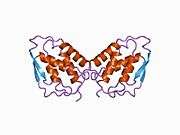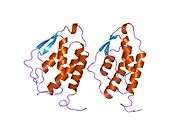Granulocyte macrophage colony-stimulating factor
| View/Edit Human | View/Edit Mouse |
| Granulocyte-macrophage colony-stimulating factor | |||||||||
|---|---|---|---|---|---|---|---|---|---|
 three-dimensional structure of recombinant human granulocyte-macrophage colony-stimulating factor (rhGM_CSF) | |||||||||
| Identifiers | |||||||||
| Symbol | GM_CSF | ||||||||
| Pfam | PF01109 | ||||||||
| Pfam clan | CL0053 | ||||||||
| InterPro | IPR000773 | ||||||||
| PROSITE | PDOC00584 | ||||||||
| SCOP | 2gmf | ||||||||
| SUPERFAMILY | 2gmf | ||||||||
| |||||||||
 | |
| Clinical data | |
|---|---|
| ATC code | L03AA09 (WHO) |
| Identifiers | |
| |
| CAS Number |
83869-56-1 |
| DrugBank |
DB00020 |
| ChemSpider | none |
| Chemical and physical data | |
| Formula | C639H1006N168O196S8 |
| Molar mass | 14434.5 g/mol |
| | |
Granulocyte-macrophage colony-stimulating factor (GM-CSF), also known as colony stimulating factor 2 (CSF2), is a monomeric glycoprotein secreted by macrophages, T cells, mast cells, NK cells, endothelial cells and fibroblasts that functions as a cytokine. The pharmaceutical analogs of naturally occurring GM-CSF are called sargramostim and molgramostim.
Function
GM-CSF is a monomeric glycoprotein that functions as a cytokine - it is a white blood cell growth factor.[3] GM-CSF stimulates stem cells to produce granulocytes (neutrophils, eosinophils, and basophils) and monocytes. Monocytes exit the circulation and migrate into tissue, whereupon they mature into macrophages and dendritic cells. Thus, it is part of the immune/inflammatory cascade, by which activation of a small number of macrophages can rapidly lead to an increase in their numbers, a process crucial for fighting infection.
GM-CSF also has some effects on mature cells of the immune system. These include, for example, inhibiting neutrophil migration and causing an alteration of the receptors expressed on the cells surface.[4]
GM-CSF signals via signal transducer and activator of transcription, STAT5.[5] In macrophages, it has also been shown to signal via STAT3. The cytokine activates macrophages to inhibit fungal survival. It induces deprivation in intracellular free zinc and increases production of reactive oxygen species that culminate in fungal zinc starvation and toxicity.[6] Thus, GM-CSF facilitates development of the immune system and promotes defense against infections.
GM-CSF also plays a role in embryonic development by functioning as an embryokine produced by reproductive tract.[7]
Genetics
The human gene has been localized to a cluster of related genes at chromosome region 5q31, which is known to be associated with interstitial deletions in the 5q- syndrome and acute myelogenous leukemia. Genes in the cluster include those encoding interleukins 4, 5, and 13.[8]
Glycosylation
Human granulocyte macrophage colony-stimulating factor is glycosylated in its mature form.
Medical use
GM-CSF is manufactured using recombinant DNA technology and is marketed as a protein therapeutic called molgramostim or, when the protein is expressed in yeast cells, sargramostim. It is used as a medication to stimulate the production of white blood cells and thus prevent neutropenia following chemotherapy.[9]
GM-CSF has also been evaluated in clinical trials for its potential as a vaccine adjuvant in HIV-infected patients.[10][11]
Sargramostim
The sequence of human GM-CSF was first identified in 1985 and soon three recominbant human GM-CSFs were produced, one in bacteria, one in mammalian cells, and one in yeast;[12] Immunex developed GM-CSF manufactured in yeast into sargramostim ( Leukine).[13] Clinical trials of sargramostim were initiated in 1987;[14] in that same year it was administered to six people as part of a compassionate-use protocol for the victims of cesium irradiation from the Goiânia accident.[15]
It was approved by the FDA in March 1991 under the trade name Leukine for acceleration of white blood cell recovery following autologous bone marrow transplantation in patients with non-Hodgkin's lymphoma, acute lymphocytic leukemia, or Hodgkin's disease.[16] In November 1996, the FDA also approved sargramostim for treatment of fungal infections and replenishment of white blood cells following chemotherapy.[17] A liquid formulation was approved in 1995.[13] Immunex was acquired by Amgen in 2002.[14] As part of the acquisition, Leukine was spun off to Berlex, which became Bayer HealthCare in 2007.[13] In 2009, Genzyme acquired the rights to Leukine from Bayer, including the manufacturing facility in the Seattle area.[14][18][19]
Rheumatoid arthritis
GM-CSF is found in high levels in joints with rheumatoid arthritis and blocking GM-CSF may reduce the inflammation or damage. Some drugs (e.g. MOR103) are being developed to block GM-CSF.[20]
See also
- CFU-GM
- Granulocyte macrophage colony-stimulating factor receptor
- Filgrastim (Neupogen, a granulocyte colony-stimulating factor (G-CSF) analog)
- Pegfilgrastim (Neulasta, a PEGylated form filgrastim)
References
- ↑ "Human PubMed Reference:".
- ↑ "Mouse PubMed Reference:".
- ↑ Francisco-Cruz A, Aguilar-Santelises M, Ramos-Espinosa O, Mata-Espinosa D, Marquina-Castillo B, Barrios-Payan J, Hernandez-Pando R (Jan 2014). "Granulocyte-macrophage colony-stimulating factor: not just another haematopoietic growth factor". Medical Oncology. 31 (1): 774. doi:10.1007/s12032-013-0774-6. PMID 24264600.
- ↑ Gasson JC (Mar 1991). "Molecular physiology of granulocyte-macrophage colony-stimulating factor". Blood. 77 (6): 1131–45. PMID 2001448.
- ↑ Voehringer D (Oct 2012). "Basophil modulation by cytokine instruction". European Journal of Immunology. 42 (10): 2544–50. doi:10.1002/eji.201142318. PMID 23042651.
- ↑ Subramanian Vignesh K, Landero Figueroa JA, Porollo A, Caruso JA, Deepe GS (Oct 2013). "Granulocyte macrophage-colony stimulating factor induced Zn sequestration enhances macrophage superoxide and limits intracellular pathogen survival". Immunity. 39 (4): 697–710. doi:10.1016/j.immuni.2013.09.006. PMC 3841917
 . PMID 24138881.
. PMID 24138881. - ↑ Hansen PJ, Dobbs KB, Denicol AC (Sep 2014). "Programming of the preimplantation embryo by the embryokine colony stimulating factor 2". Animal Reproduction Science. 149 (1-2): 59–66. doi:10.1016/j.anireprosci.2014.05.017. PMID 24954585.
- ↑ "Entrez Gene: CSF2 colony stimulating factor 2 (granulocyte-macrophage)".
- ↑ Vacchelli E, Eggermont A, Fridman WH, Galon J, Zitvogel L, Kroemer G, Galluzzi L (Jul 2013). "Trial Watch: Immunostimulatory cytokines". Oncoimmunology. 2 (7): e24850. doi:10.4161/onci.24850. PMC 3782010
 . PMID 24073369.
. PMID 24073369. - ↑ Hellerstein M, Xu Y, Marino T, Lu S, Yi H, Wright ER, Robinson HL (Nov 2012). "Co-expression of HIV-1 virus-like particles and granulocyte-macrophage colony stimulating factor by GEO-D03 DNA vaccine". Human Vaccines & Immunotherapeutics. 8 (11): 1654–8. doi:10.4161/hv.21978. PMC 3601140
 . PMID 23111169.
. PMID 23111169. - ↑ Iyer SS, Amara RR (2014). "DNA/MVA Vaccines for HIV/AIDS". Vaccines. 2 (1): 160–78. doi:10.3390/vaccines2010160. PMC 4494194
 . PMID 26344473.
. PMID 26344473. - ↑ Armitage JO (December 1998). "Emerging applications of recombinant human granulocyte-macrophage colony-stimulating factor". Blood. 92 (12): 4491–508. PMID 9845514.
- 1 2 3 Staff (May 2008). "Back to the Future: Original Liquid Leukine® Coming Soon" (PDF). Oncology Business Review.
- 1 2 3 "Immunex Corporation". Company Histories & Profiles. FundingUniverse.com. Retrieved 12 November 2011.
- ↑ Schmeck HM (1987-11-02). "Radiation Team Sent to Brazil Saves Two With a New Drug". New York Times. Retrieved 2012-06-20.
- ↑ "Approval Summary for sargramostim". Oncology Tools. U.S. Food and Drug Administration, Center for Drug Evaluation and Research. 1991-03-05. Archived from the original on 2007-06-24. Retrieved 20 September 2009.
- ↑ "Newly Approved Drug Therapies (179): Leukine (sargramostim), Immunex". CenterWatch. Retrieved 2008-10-12.
- ↑ "Bayer Healthcare Pharmaceuticals Plant, Snohomish County, Washington State". pharmaceutical-technology.com. Retrieved 12 November 2011.
- ↑ "Genzyme and Bayer HealthCare Enter New Strategic Agreement". Genzyme. March 31, 2009. Retrieved 12 November 2011.
- ↑ Deiß A, Brecht I, Haarmann A, Buttmann M (Mar 2013). "Treating multiple sclerosis with monoclonal antibodies: a 2013 update". Expert Review of Neurotherapeutics. 13 (3): 313–35. doi:10.1586/ern.13.17. PMID 23448220.
External links
- Official gentaur web site
- Official Leukine web site
- Granulocyte-Macrophage Colony-Stimulating Factor at the US National Library of Medicine Medical Subject Headings (MeSH)

